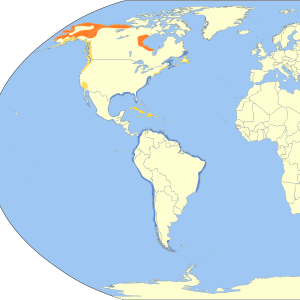Hudsonian whimbrel facts for kids
Quick facts for kids Hudsonian whimbrel |
|
|---|---|
 |
|
| Scientific classification | |
 |
|
| Synonyms | |
|
The Hudsonian whimbrel (Numenius hudsonicus) is a type of wader bird. It belongs to the large sandpiper family, called Scolopacidae. This bird is one of the most common curlews. It lives and has its babies in many parts of subarctic North America.
Recently, scientists decided to separate this bird from the Eurasian whimbrel. Some experts still think they are the same species. The whimbrel is a migratory bird. This means it travels long distances. It spends its winters along the coasts of southern North America and South America. During its travels, it also stays near the coast. These birds often gather in groups when it's not breeding season.
In the mangrove forests of Colombia, whimbrels choose safe places to rest. These spots are close to where they find food. They are also away from predators that might come from the mainland. However, these resting spots might still be near places where humans are active.
About the Hudsonian Whimbrel
The Hudsonian whimbrel is a fairly large wader. But among the curlew family, it's a medium-sized bird. Its English name, "whimbrel," sounds like the bird's call.
This bird is about 37 to 47 centimeters (15 to 19 inches) long. Its wingspan can be 75 to 90 centimeters (30 to 35 inches). It weighs between 270 and 493 grams (9.5 to 17.4 ounces). The whimbrel is mostly grayish-brown. It has a white back. It also has a long, curved bill. The female's bill is usually the longest. This bill has a slight bend, not a smooth curve. Whimbrels are generally cautious birds.
The usual call of this bird is a soft, rippling whistle. When it sings, the whistle becomes a longer trill.
The only other common birds that look similar are larger curlews. The whimbrel is smaller than these. It has a shorter, downward-curved bill. It also has a stripe down the middle of its head. Strong stripes above its eyes help tell it apart.
Types of Hudsonian Whimbrels
There are two main types, or subspecies, of the Hudsonian whimbrel:
- Numenius hudsonicus rufiventris: This type is found in Alaska and northwestern Canada.
- Numenius hudsonicus hudsonicus: This type is also known as the Hudsonian curlew. It lives in the Hudson Bay area and northeastern Canada.
Life and Habits
The Hudsonian whimbrel finds its food by poking its bill into soft mud. It looks for small invertebrates, like worms or insects. It also picks up small crabs and similar prey from the surface. Before they migrate, berries become a very important part of their diet.
Reproduction
The nest of a whimbrel is a simple scrape on the ground. They make these nests in the tundra or Arctic moorland. The female usually lays three to five eggs. Adult whimbrels are very protective of their nesting area. They will even attack humans who come too close to their nests.
Towards the end of the 1800s, many whimbrels were hunted. This caused their numbers to drop a lot. However, the population has grown back since then.

